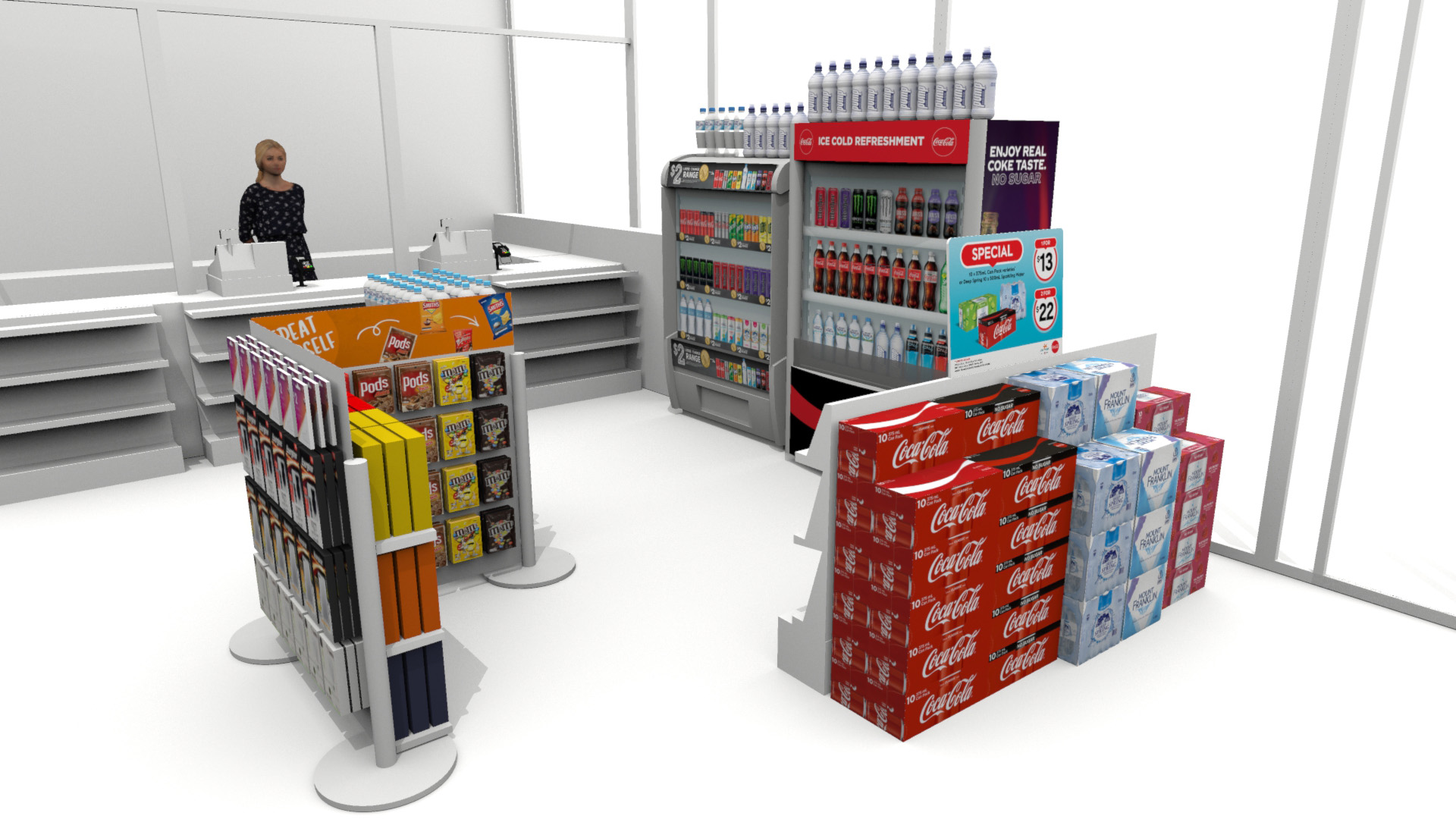When you enter a retail store, you’re immediately met with vibrant displays, signage, and strategically placed products. These touch points are all examples of point of sale (POS) marketing – a powerful tool that can bring significant benefits to your business. In this blog, we’ll delve into the important benefits of in-store POS marketing and share tips to help you maximise its impact on your business.
What is In-Store Point of Sale Marketing?
In-store point of sale marketing refers to promotional materials and displays placed in (or around) the area where a transaction occurs, such as checkouts, aisles, end caps, or other high-traffic zones within a store (Simpson Group 2023). Common in-store POS examples include:
- Shelf talkers & wobblers
- Posters (with promotions QR code)
- Counter cards
- Wall, floor, window, or glass decal stickers
- Tri-cards
- Table talkers
- Branded clothing (i.e., beanies)
- Gondola headers
- Case stackers.
The key advantage of POS marketing is its ability to engage customers precisely when they’re ready to purchase, maximising the impact at a critical decision-making moment. Check out an in-store POS, designed by Adlab using SketchUp!
Importance of In-Store Point of Sale Marketing
1. Brand and Product Awareness
Firstly, in-store point of sale marketing significantly boosts brand and product awareness, critical for every business. Positioned in high-traffic areas, in-store POS displays not only highlight key products but also enhance your brand’s visibility. As shoppers browse aisles or wait in line, eye-catching elements like shelf-talkers, wobblers, decals, and case stackers are more likely to stand out, helping your brand cut through the noise.
This is important for swaying customers, particularly those who hadn’t originally considered your brand or product, turning casual interest into purchases (The Finishing Post 2024). However, in-store point of sale materials do more than just drive impulse buys. They also embed your brand in consumers’ minds, establishing recognition and trust. For new or lesser-known brands, this exposure is critical!
By consistently positioning your product in prominent locations, and utilising visually engaging POS materials, this will strengthen your brand presence, and prompt customers to actively seek out your product during future shopping trips, driving sustained brand loyalty and long-term growth (Birch Print 2023).
2. Telling Your Brand Story
In-store point of sale displays are also vital for telling your brand’s story, directly to consumers ready to make purchases.
By creatively integrating your brand’s values, mission, and messaging into eye-catching POS materials (like posters, displays, or case stackers), this crafts a strong identity that will have a memorable impact. Whether it’s your commitment to sustainability, the heritage behind your brand, or your unique offerings, this helps:
- Create an emotional connection with your brand.
- Reinforce key messages you want customers to recall (long after leaving the store)
Research shows that 55% of consumers are more likely to purchase from brands they resonate with on a personal level (Birch 2023), underscoring the importance of utilising well-designed, consistent POS materials to convey your unique narrative, and build brand loyalty!
3. Flexibility & Market Response
Brands can also leverage the flexibility of in-store point of sale marketing to run seasonal pop-ups, and targeted promotions during peak shopping periods (like Christmas and Easter). This adaptability allows for timely, high-impact campaigns that capture consumers’ attention when they’re most receptive.
Additionally, these displays enable brands to swiftly respond to market shifts, whether launching a new product or seizing emerging trends. Customising point of sale marketing materials to align with current consumer demands helps brands stay competitive and relevant. This agility ensures that your marketing efforts remain fresh and resonate with your target audience, driving greater engagement.
4. Promotions & Retargeting Opportunities
In-store point of sale marketing also importantly provides opportunities to advertise promotions and in turn:
- Boost sales (through participating products).
- Retarget consumers.
Commonly, POS elements like posters, wobblers, and counter cards utilise QR codes, requiring participants to enter their details for competition entry. This is effective in providing more ways for shoppers to enter, increasing the likelihood of participation. Further, it is crucial for re-targeting efforts, allowing brands to engage with customers not only during the current promotion but also for future campaigns.
Effective re-targeting ensures that customers are reminded of new or ongoing promotions, increasing their likelihood of participation, and consequently, boosting the potential for future purchases. By leveraging this data, brands can drive higher engagement and conversion rates across their promotional activities.
5. Increases Sales
By enhancing brand visibility and encouraging impulsive buying behaviour, in-store point of sale marketing can also significantly increase sales. This strategy is particularly effective in high-traffic zones like checkout lines, where the limited decision-making time increases the chance of quick, unplanned purchases.
Additionally, incorporating enticing promotions— like discounts, “buy one, get one free” deals, or promotions that require purchasing participating products—can further influence customers to choose your brand over competitors, driving both immediate sales and repeat business.
6. Improved Customer Experience
Above all, enhancing the customer experience is the most-important aspect of point of sale marketing, as it provides clear, visually engaging information that guides shoppers effectively. Well-designed displays help customers:
- Discover new products
- Understand & access promotions
- Navigate the store more efficiently (without wandering aimlessly).
In so doing, this reduces frustration and decision fatigue (Quelch & Cannon-Bonventre 1998). Further, by offering relevant product details, and highlighting value, in-store point of sale marketing also creates a smoother, more enjoyable shopping journey (see our path to purchase blog for more information!).
This enhanced experience not only increases the likelihood of purchases but also fosters brand loyalty and repeat visits. Further, a positive in-store experience increases the likelihood of word-of-mouth recommendations, strengthening your reputation, and driving long-term business growth and sales!
Tips to Maximise Your In-Store Point of Sale Marketing!
Want to create in-store POS, or looking to improve your pre-existing materials? Here are our tips for improving your in-store point of sale marketing:
- Optimise Placement: Ensure you position your POS materials in high-traffic areas to ensure maximum visibility and engagement.
- Enhance Design: Use eye-catching graphics and clear messaging to attract attention and convey the offer quickly (Adlab can help!)
- Personalise Offers: Tailor promotions based on customer purchase history, or preferences to make them more relevant.
- Track Performance: Monitor the effectiveness of POS promotions through analytics to refine strategies and improve future campaigns.
Concluding Thoughts
To conclude, in-store point of sale marketing is a powerful tool that can transform a shopper’s experience and significantly boost your business’s bottom line. By strategically placing engaging displays and promotional materials in high-traffic areas, you can increase brand visibility, drive impulse purchases, and foster long-term customer loyalty. From telling your brand story to responding swiftly to market trends, POS marketing offers flexibility and opportunities for impactful promotions. When executed effectively, it not only enhances the shopping experience but also leads to sustained business growth and increased sales.
Need help with your POS materials? Get in touch with Adlab today!







